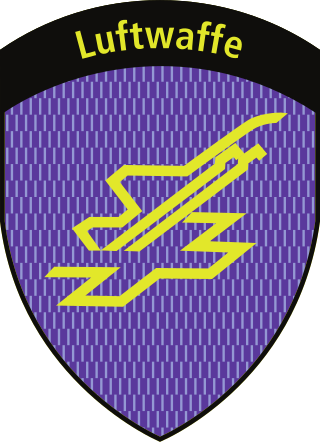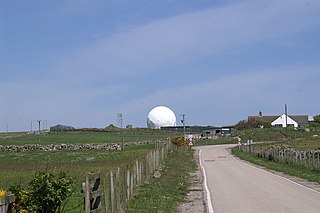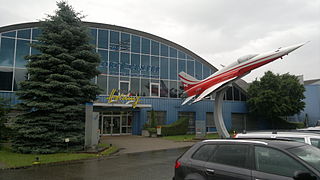
The NATO Integrated Air Defense System is a command and control network combining radars and other facilities spread throughout the NATO alliance's air defence forces. It formed in the mid-1950s and became operational in 1962 as NADGE. It has been constantly upgraded since its formation, notably with the integration of Airborne Early Warning aircraft in the 1970s. The United Kingdom maintained its own network, but was fully integrated with the network since the introduction of the Linesman/Mediator network in the 1970s. Similarly, the German network maintained an independent nature through GEADGE.

North American Aerospace Defense Command, known until March 1981 as the North American Air Defense Command, is a combined organization of the United States and Canada that provides aerospace warning, air sovereignty, and protection for Canada and the continental United States.

The Swiss Air Force is the air component of the Swiss Armed Forces, established on 31 July 1914, three days after the outbreak of World War I, as a part of the army and in October 1936 as an independent service.

The Austrian Air Force is a component part of the Austrian Armed Forces.
Skyguide is an air navigation service provider which manages and monitors Swiss airspace. The company, which was formerly known as Swisscontrol, changed its name to skyguide in 2001. Skyguide is a joint-stock company under Swiss private law which is responsible, on behalf of the Swiss Confederation, for ensuring the safety of all Swiss airspace and of adjoining airspace areas in Germany, Austria, France and Italy that have been delegated to its control. For Swiss airspace, this duty extends to both civil and military air navigation services.

An airport surveillance radar (ASR) is a radar system used at airports to detect and display the presence and position of aircraft in the terminal area, the airspace around airports. It is the main air traffic control system for the airspace around airports. At large airports it typically controls traffic within a radius of 60 miles (96 km) of the airport below an elevation of 25,000 feet. The sophisticated systems at large airports consist of two different radar systems, the primary and secondary surveillance radar. The primary radar typically consists of a large rotating parabolic antenna dish that sweeps a vertical fan-shaped beam of microwaves around the airspace surrounding the airport. It detects the position and range of aircraft by microwaves reflected back to the antenna from the aircraft's surface. The secondary surveillance radar consists of a second rotating antenna, often mounted on the primary antenna, which interrogates the transponders of aircraft, which transmits a radio signal back containing the aircraft's identification, barometric altitude, and an emergency status code, which is displayed on the radar screen next to the return from the primary radar.

The Western Air Defense Sector (WADS) is a unit of the Washington Air National Guard located at Joint Base Lewis-McChord, Tacoma, Washington.

The Estonian Air Force is the aviation branch of the Estonian Defence Forces. The air force traces its history to 1918, and was re-established in its current form in 1991.

Remote Radar Head Buchan or RRH Buchan is an air defence radar station operated by the Royal Air Force. It is located at Stirling Hill, 3.2 kilometres (2.0 mi) south of Peterhead on the Aberdeenshire coast of North East Scotland.

Quick Reaction Alert (QRA) is state of readiness and modus operandi of air defence maintained at all hours of the day by NATO air forces. The United States usually refers to Quick Reaction Alert as 'Airspace Control Alert'.
GIADS - German Improved Air Defence System - is the standard Air Command and Control System of the German Air Force Tactical Command and Control Service.

TAFLIR is the abbreviation for the "Tactical Flight Radar" of the Swiss Air Force. TAFLIR is used to improve the Recognized Air Picture and to support air traffic control and air surveillance of the Swiss Air Force.

FLORAKO is a Swiss radar system for military and civil aviation. The acronym stands for FLORIDA radar replacement air radar system capable communication system in the initial phase of the project meant the name FLORES RALUS KOMSYS and emerged from the project name of the sub-systems. There are four surface to air missile tubes located on the site.

The Target allocation radar TPS-1E is an omnidirectional pulse radar device. It was used from 1958 until 1989 by the Swiss Air Force. It was also used by German army (Heer) air defence reconnaissance platoons up until the early 1990s.

The Super Fledermaus, known in Swiss service as the Feuerleitgerät 63, Flt Gt 63, is a pulse-radar fire control system, 111 of these systems were in service with the Swiss Air Force from 1965 to 1977. Under the lead of Contraves, the Super Fledermaus fire control system was jointly developed and produced by ten companies. It replaced the Fire control radar Mark VII in Swiss service, and was in turn replaced by the Skyguard system.

The Flieger Flab Museum is located in the Canton of Zurich in Dübendorf on the grounds of Dübendorf Air Base. In the museum, 40 airplanes and helicopters are displayed, with the collection divided into distinct eras: pioneers and World War I, the 1930s, World War II and the postwar period, the beginning of the jet age, the development of jet fighters, the Cold War, and arms reduction.

The LGR-1 was used by Swiss Air Force from 1948 until 1955 for positioning the planned radar air surveillance system. It is now in the Flieger-Flab-Museum at Dübendorf.

The FLORIDA Airspace Monitoring And Management System was an airspace monitoring and management system of the Swiss Air Force. It was built by the Hughes Aircraft Company in Fullerton, California.

Dübendorf Military Airport was a military airfield of the Swiss Air Force northeast of Dübendorf in Switzerland, located east of Zürich.
The Militärhistorische Stiftung des Kantons Zug MHSZ is a foundation consisting of a group of Military Museums in the canton of Zug with the purpose of safeguarding and cultivating the military heritage of the Swiss Confederation in the canton of Zug.


















